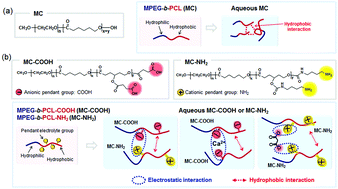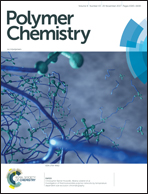Temperature-responsive hydrogels via the electrostatic interaction of amphiphilic diblock copolymers with pendant-ion groups†
Abstract
In this work, we prepared amphiphilic polyester diblock copolymers with pendant ion groups and examined the formation of temperature-responsive hydrogels via the electrostatic interaction of cationic or anionic pendant groups. We prepared methoxy polyethylene glycol-b-poly(ε-caprolactone) (MC) diblock copolymers with a carboxylic acid (MC-COOH) or an amine (MC-NH2) (3–13 mol%) at the pendant position of the hydrophobic polyester segments. The MC-COOH and MC-NH2 were polyelectrolytes with negative and positive zeta potentials, respectively. Each MC-COOH or MC-NH2 suspension exhibited sol-to-gel phase transition with dependence on the identities and concentrations of the pendant group. The mixed suspensions of the MC-COOH and MC-NH2 also exhibited sol-to-gel phase transitions via attractive electrostatic interactions. The quantitative net zeta potential of the MC-COOH and MC-NH2 was due to the attractive electrostatic interactions between the COOH and NH2 pendant groups on the MC segments. The suspensions of the MC-(COO−Na+)10 with calcium chloride (CaCl2) and MC-(NH3+Cl−)10 with malonic acid (MA) exhibited gel-to-sol phase transitions, albeit slightly, with dependence on the identities and concentrations of the CaCl2 and MA. Each MC-COOH or MC-NH2 suspension, mixed suspension, and suspension with its corresponding counter ions showed crystallinity, indicating hydrophobic aggregation between the hydrophobic MC segments with dependence on the electrostatic interactions between the polyelectrolytes. In summary, we developed temperature-responsive hydrogels via the electrostatic interactions of MC-COOH and MC-NH2.



 Please wait while we load your content...
Please wait while we load your content...